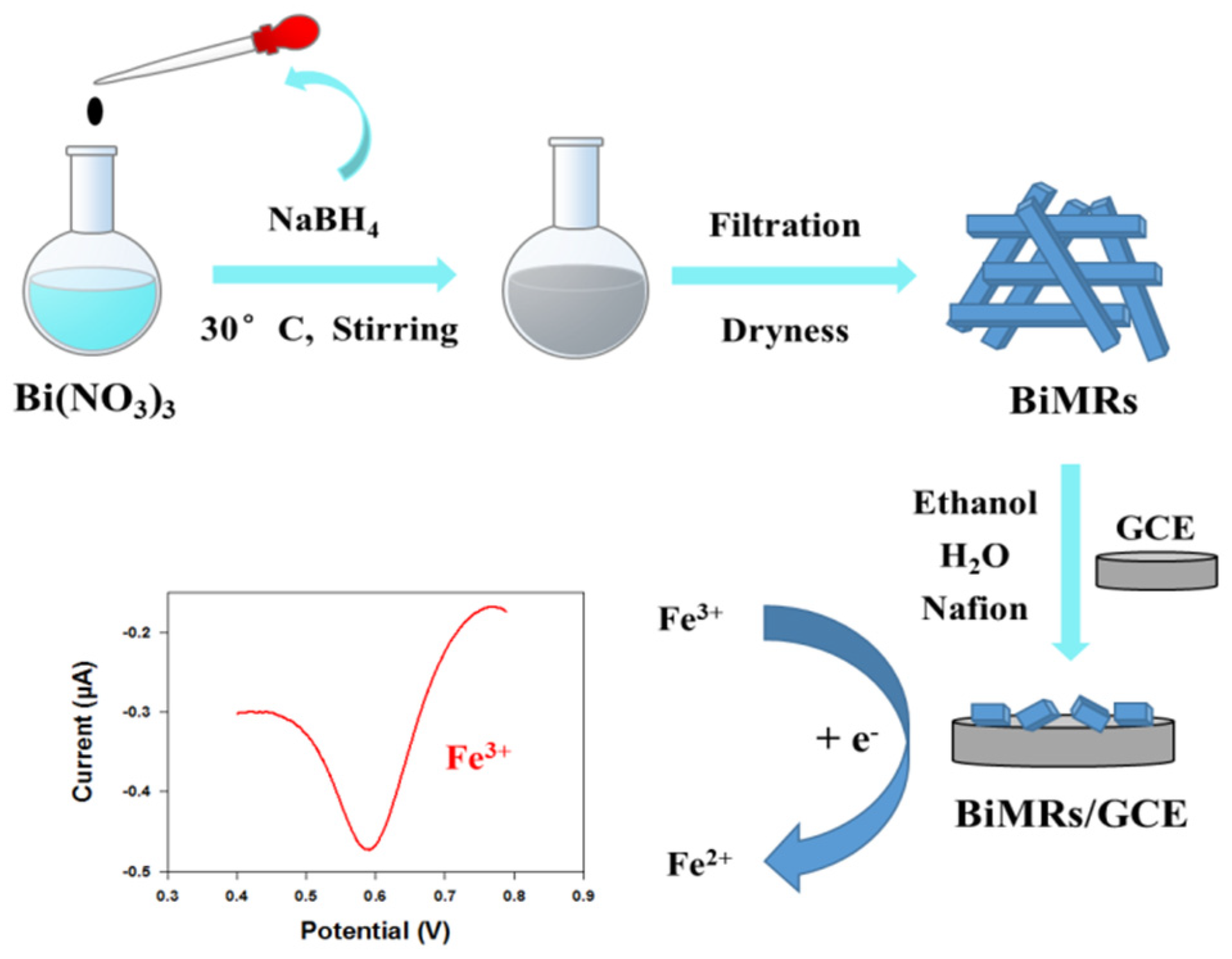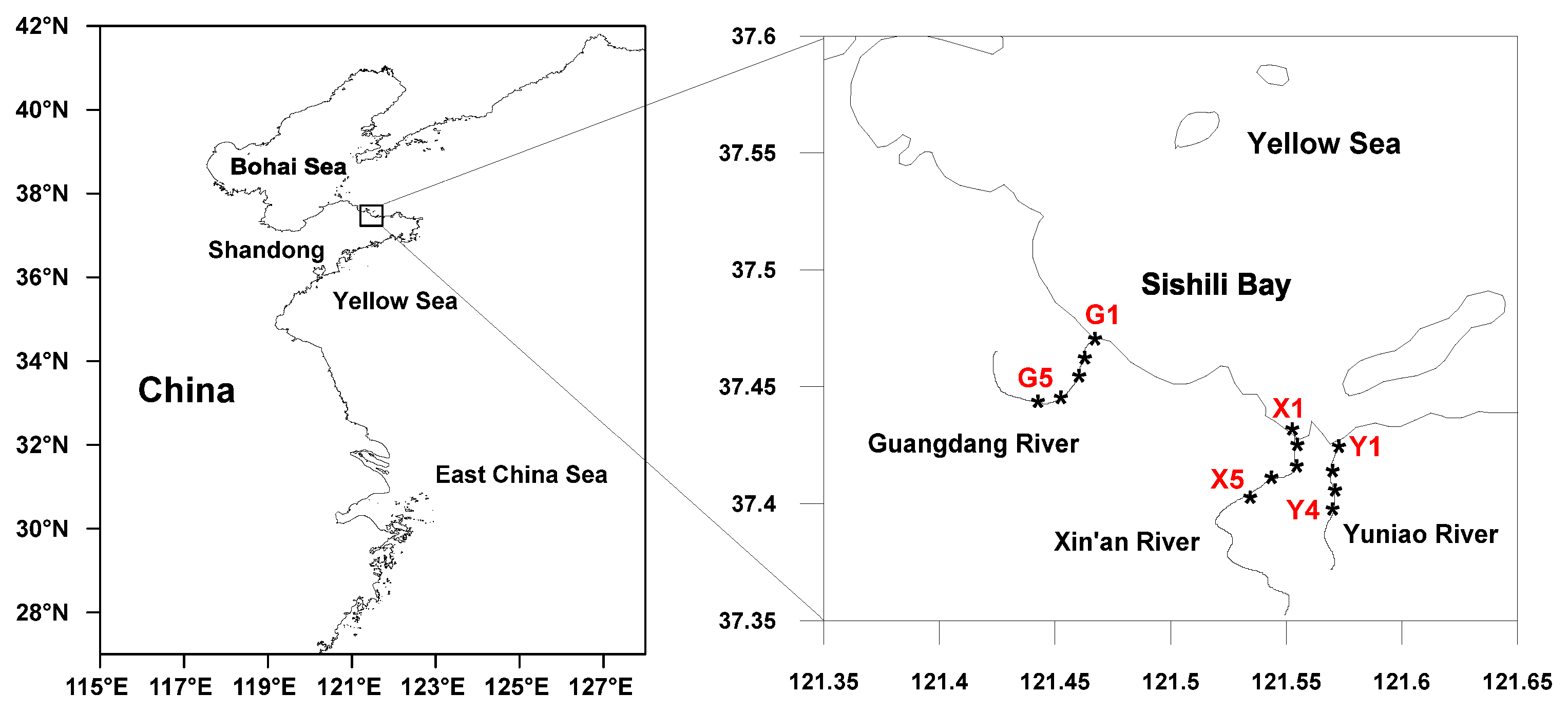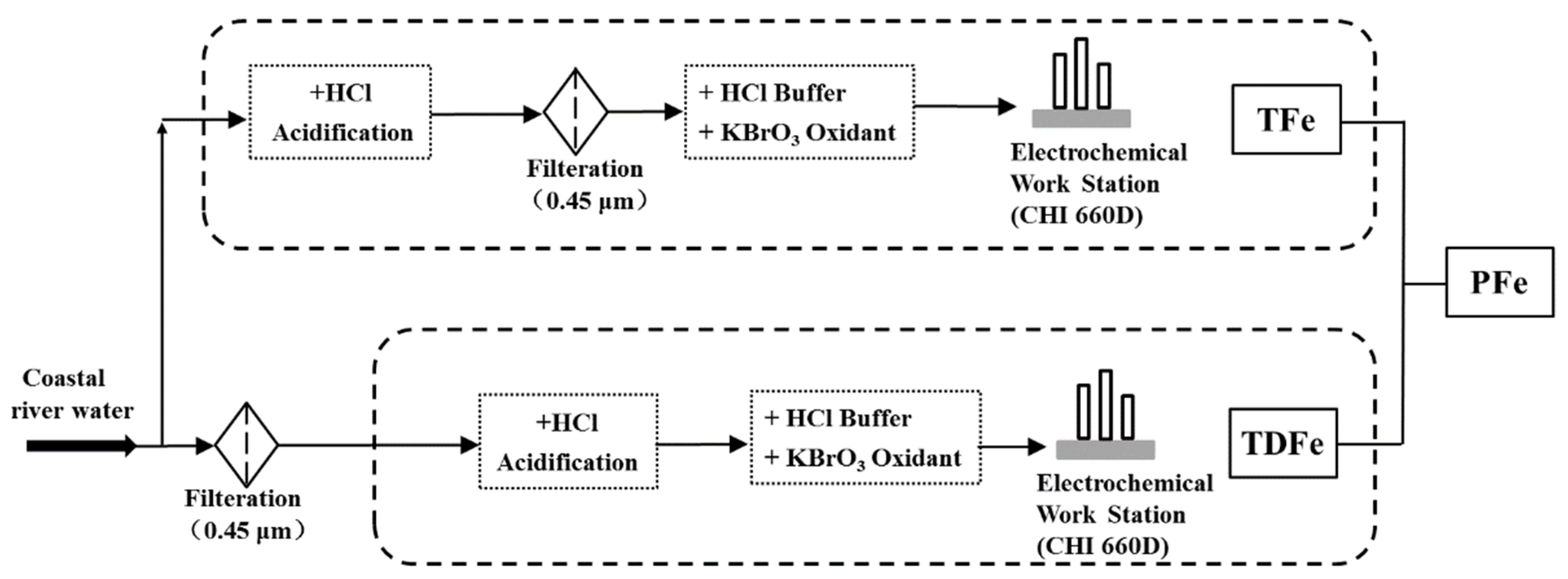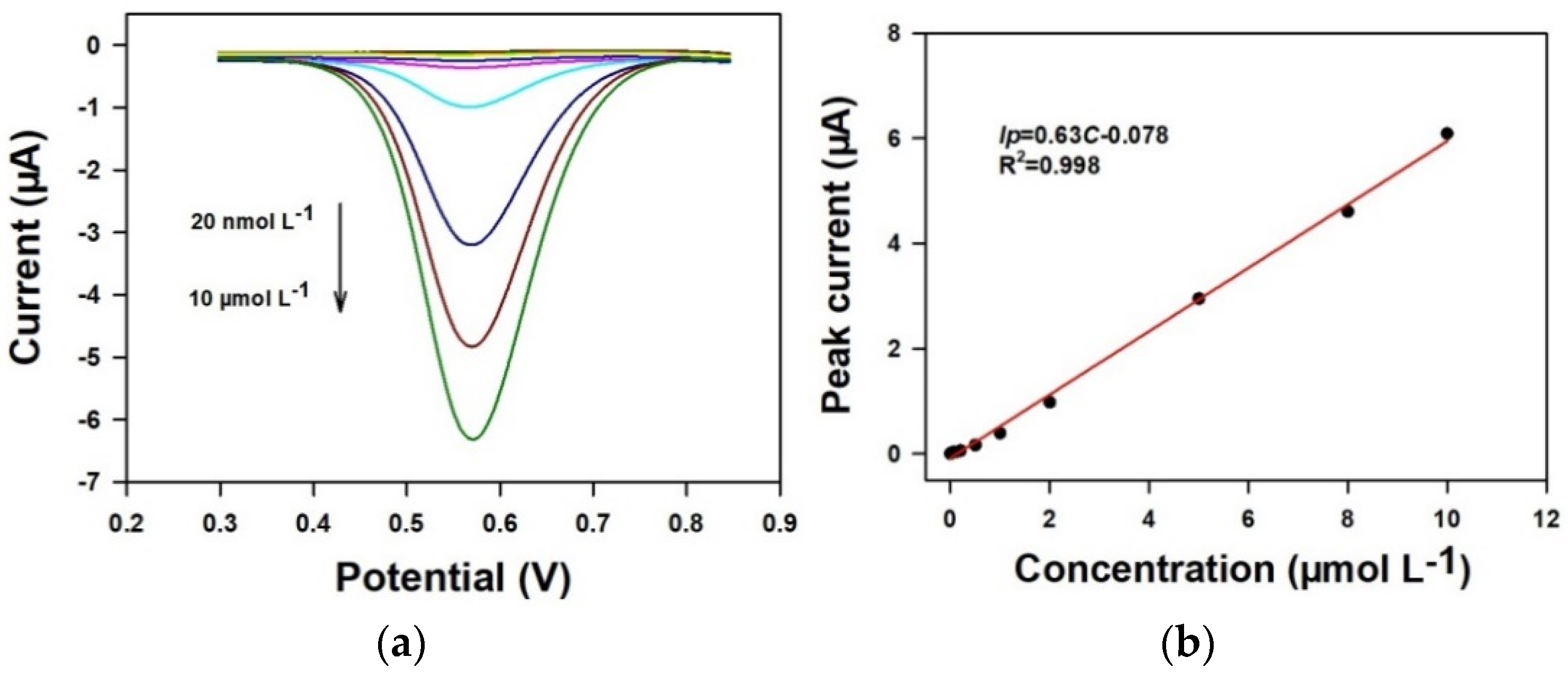Fractionation Analysis of Iron in Coastal Rivers to Yantai Sishili Bay with a Bismuth Microrods-Based Electrochemical Sensor
Abstract
:1. Introduction
2. Materials and Methods
2.1. Reagents and Materials
2.2. Apparatus
2.3. Preparation of the BiMRs/GCE
2.4. Collection and Processing of Coastal River Water Samples
2.5. Electrochemical Analysis Procedure
3. Results and Discussion
3.1. Characterization of the BiMRs/GCE
3.2. Voltammetric Response of Fe3+ on the BiMRs/GCE
3.3. Performance and Verification of BiMRs/GCE for Fe Determination
3.4. Fractionation Analysis of Fe in Coastal River Waters
3.5. Concentration Distribution of Different Fractions of Fe in Coastal River Waters
3.6. Correlation Analysis of Fe Fractions with Physical and Chemical Parameters
4. Conclusions
Author Contributions
Funding
Institutional Review Board Statement
Informed Consent Statement
Data Availability Statement
Acknowledgments
Conflicts of Interest
References
- Taylor, S.R. Abundance of chemical elements in the continental crust: A new table. Geochim. Cosmochim. Acta 1964, 28, 1273–1285. [Google Scholar] [CrossRef]
- Laglera, L.M.; Santos-Echeandía, J.; Caprara, S.; Monticelli, D. Quantification of iron in seawater at the low picomolar range based on optimization of Bromate/Ammonia/Dihydroxynaphtalene system by catalytic adsorptive cathodic stripping voltammetry. Anal. Chem. 2013, 85, 2486–2492. [Google Scholar] [CrossRef] [Green Version]
- Worsfold, P.J.; Lohan, M.C.; Ussher, S.J.; Bowie, A.R. Determination of dissolved iron in seawater: A historical review. Mar. Chem. 2014, 166, 25–35. [Google Scholar] [CrossRef] [Green Version]
- Lu, M.; Rees, N.V.; Kabakaev, A.S.; Compton, R.G. Determination of iron: Electrochemical methods. Electroanalysis 2012, 24, 1693–1702. [Google Scholar] [CrossRef]
- Zhu, Y.; Pan, D.; Hu, X.; Han, H.; Lin, M.; Wang, C. An electrochemical sensor based on reduced graphene oxide/gold nanoparticles modified electrode for determination of iron in coastal waters. Sens. Actuators B Chem. 2017, 243, 1–7. [Google Scholar] [CrossRef]
- Melton, E.D.; Swanner, E.D.; Behrens, S.; Schmidt, C.; Kappler, A. The interplay of microbially mediated and abiotic reactions in the biogeochemical Fe cycle. Nat. Rev. Microbiol. 2014, 12, 797–808. [Google Scholar] [CrossRef]
- Martin, J.H.; Fitzwaterr, S. Iron deficiency limits phytoplank-ton growth in the north-east Pacific subarctic. Nature 1988, 331, 341–343. [Google Scholar] [CrossRef]
- Han, H.; Pan, D. Voltammetric methods for speciation analysis of trace metals in natural waters. Trends Environ. Anal. Chem. 2021, 29, e00119. [Google Scholar] [CrossRef]
- Wells, M.L.; Trick, C.G. Controlling iron availability to phytoplankton in iron-replete coastal waters. Mar. Chem. 2004, 86, 1–13. [Google Scholar] [CrossRef]
- Anderson, M.A.; Morel, F.M.M. The influence of aqueous iron chemistry on the uptake of iron by the coastal diatom Thalassiosira weissflogii. Limnology 1982, 27, 789–813. [Google Scholar] [CrossRef]
- De Jonge, M.; Lofts, S.; Bervoets, L.; Blust, R. Relating metal exposure and chemical speciation to trace metal accumulation in aquatic insects under natural field conditions. Sci. Total Environ. 2014, 496, 11–21. [Google Scholar] [CrossRef] [Green Version]
- Laglera, L.M.; Monticelli, D. Iron detection and speciation in natural waters by electrochemical techniques: A critical review. Curr. Opin. Electrochem. 2017, 3, 123–129. [Google Scholar] [CrossRef]
- Gledhill, M.; van den Berg, C.M.G. Determination of complexation of iron(III) with natural organic complexing ligands in seawater using cathodic stripping voltammetry. Mar. Chem. 1994, 47, 41–54. [Google Scholar] [CrossRef]
- Van den Berg, C.M.G. Chemical speciation of iron in seawater by cathodic stripping voltammetry with dihydroxynaphthalene. Anal. Chem. 2006, 78, 156–163. [Google Scholar] [CrossRef] [PubMed]
- Croot, P.L.; Johansson, M. Determination of iron speciation by cathodic stripping voltammetry in seawater using the competing ligand 2-(2-Thiazolylazo)-p-cresol (TAC). Electroanalysis 2000, 12, 565–576. [Google Scholar] [CrossRef]
- Abualhaija, M.M.; van den Berg, C.M.G. Chemical speciation of iron in seawater using catalytic cathodic stripping voltammetry with ligand competition against salicylaldoxime. Mar. Chem. 2014, 164, 60–74. [Google Scholar] [CrossRef]
- Pesavento, M.; Alberti, G.; Biesuz, R. Analytical methods for determination of free metal ion concentration, labile species fraction and metal complexation capacity of environmental waters: A review. Anal. Chim. Acta 2009, 631, 129–141. [Google Scholar] [CrossRef]
- Annibaldi, A.; IIIuminati, S.; Truzzi, C.; Libani, G.; Scarponi, G. Pb, Cu and Cd distribution in five estuary systems of Marche, central Italy. Mar. Pollut. Bull. 2015, 96, 441–449. [Google Scholar] [CrossRef]
- Han, H.; Pan, D.; Pan, F.; Hu, X.; Zhu, R. A functional micro-needle sensor for voltammetric determination of iron in coastal waters. Sens. Actuators B Chem. 2021, 327, 128883. [Google Scholar] [CrossRef]
- Zhu, Y.; Hu, X.; Pan, D.; Han, H.; Lin, M.; Lu, Y.; Wang, C.; Zhu, R. Speciation determination of iron and its spatial and seasonal distribution in coastal river. Sci. Rep. 2018, 8, 2576. [Google Scholar] [CrossRef] [Green Version]
- Wang, Z.Q.; Liu, G.; Zhang, L.N.; Wang, H. A bismuth modified hybrid binder carbon paste electrode for electrochemical stripping detection of trace heavy metals in soil. Int. J. Electrochem. Sci. 2012, 7, 12326–12339. [Google Scholar]
- Li, Y.; Sun, G.; Zhang, Y.; Ge, C.; Bao, N.; Wang, Y. A glassy carbon electrode modified with bismuth nanotubes in a silsesquioxane framework for sensing of trace lead and cadmium by stripping voltammetry. Microchim. Acta 2014, 181, 751–757. [Google Scholar] [CrossRef]
- Lee, G.J.; Lee, H.M.; Rhee, C.K. Bismuth nano-powder electrode for trace analysis of heavy metals using anodic stripping voltammetry. Electrochem. Commun. 2007, 9, 2514–2518. [Google Scholar] [CrossRef]
- Han, H.; Pan, D.; Li, Y.; Wang, J.; Wang, C. Stripping voltammetric determination of lead in coastal waters with a functional micro-needle electrode. Front. Mar. Sci. 2020, 7, 196. [Google Scholar] [CrossRef]
- Hu, X.; Pan, D.; Han, H.; Lin, M.; Wang, C. Preparation of bismuth-based microrods and their application in electroanalysis. Mater. Lett. 2017, 190, 83–85. [Google Scholar] [CrossRef]
- Hu, X.; Pan, D.; Lin, M.; Han, H.; Li, F. Graphene oxide-assisted synthesis of bismuth nanosheets for catalytic stripping voltammetric determination of iron in coastal waters. Microchim. Acta 2016, 183, 855–861. [Google Scholar] [CrossRef]
- Liu, X.; Millero, F.J. The solubility of iron in seawater. Mar. Chem. 2002, 77, 43–54. [Google Scholar] [CrossRef]
- Sukekava, C.; Downes, J.; Slagter, H.A.; Gerringa, L.J.A.; Laglera, L.M. Determination of the contribution of humic substances to iron complexation in seawater by catalytic cathodic stripping voltammetry. Talanta 2018, 189, 359–364. [Google Scholar] [CrossRef] [PubMed]
- González, A.G.; Cadena-Aizaga, M.I.; Sarthou, G.; González-Dávila, M.; Santana-Casiano, J.M. Iron complexation by phenolic ligands in seawater. Chem. Geol. 2019, 511, 380–388. [Google Scholar] [CrossRef]
- Jiann, K.T.; Wen, L.S. Distribution and lability of dissolved iron in surface waters of maginal seas in southeastern Asia. Estuar. Coast. Shelf Sci. 2012, 100, 142–149. [Google Scholar] [CrossRef]








| Standard Samples (GSB 07-1188-2000) | Analyzed (nmol L−1) | Reference (nmol L−1) |
|---|---|---|
| Sample 1 (202414) | 117 ± 3.31 | 115 |
| Sample 2 (202415) | 513 ± 2.96 | 512 |
| Stations | Total Dissolved Fe | Particulate Fe | Total Fe | ||
|---|---|---|---|---|---|
| Concentration (nmol L−1) | Percentage (%) | Concentration (nmol L−1) | Percentage (%) | Concentration (nmol L−1) | |
| G1 | 580 ± 38 | 17.98 | 2635 ± 296 | 82.02 | 3226 ± 282 |
| G2 | 663 ± 47 | 30.92 | 1842 ± 206 | 69.08 | 2144 ± 252 |
| G3 | 433 ± 74 | 7.55 | 5301 ± 40 | 92.45 | 5735 ± 113 |
| G4 | 943 ± 66 | 6.74 | 12,652 ± 293 | 93.06 | 1359 ± 301 |
| G5 | 1091 ± 81 | 14.29 | 6546 ± 237 | 85.71 | 7637 ± 319 |
| X1 | 324 ± 29 | 16.99 | 1564 ± 87 | 83.01 | 1907 ± 74 |
| X2 | 487 ± 67 | 16.15 | 2562 ± 116 | 83.85 | 3061 ± 229 |
| X3 | 494 ± 21 | 8.49 | 5323 ± 159 | 91.51 | 5816 ± 178 |
| X4 | 451 ± 44 | 8.82 | 4677 ± 103 | 91.18 | 5114 ± 196 |
| X5 | 283 ± 32 | 11.75 | 2131 ± 89 | 88.25 | 2409 ± 73 |
| Y1 | ND 1 | -- | -- | -- | 958 ± 53 |
| Y2 | 439 ± 35 | 7.92 | 5105 ± 311 | 92.08 | 5543 ± 343 |
| Y3 | 604 ± 28 | 8.95 | 6143 ± 195 | 91.05 | 6747 ± 223 |
| Y4 | 251 ± 31 | 5.66 | 4128 ± 280 | 94.34 | 4433 ± 310 |
| Dissolved Oxygen | Conductivity | Salinity | pH | TDFe | PFe | TFe | |
|---|---|---|---|---|---|---|---|
| Dissolved oxygen | 1.00 | ||||||
| Conductivity | −0.71 2 | 1.00 | |||||
| Salinity | −0.69 2 | 0.99 2 | 1.00 | ||||
| pH | −0.09 | 0.38 | 0.38 | 1.00 | |||
| TDFe | 0.64 1 | −0.53 | −0.54 | 0.24 | 1.00 | ||
| PFe | 0.61 1 | −0.52 | −0.53 | 0.10 | 0.62 1 | 1.00 | |
| TFe | 0.57 1 | −0.47 | −0.50 | 0.12 | 0.59 1 | 0.89 2 | 1.00 |
Publisher’s Note: MDPI stays neutral with regard to jurisdictional claims in published maps and institutional affiliations. |
© 2021 by the authors. Licensee MDPI, Basel, Switzerland. This article is an open access article distributed under the terms and conditions of the Creative Commons Attribution (CC BY) license (https://creativecommons.org/licenses/by/4.0/).
Share and Cite
Hu, X.; Han, H.; Wang, C.; Song, X. Fractionation Analysis of Iron in Coastal Rivers to Yantai Sishili Bay with a Bismuth Microrods-Based Electrochemical Sensor. J. Mar. Sci. Eng. 2021, 9, 1063. https://doi.org/10.3390/jmse9101063
Hu X, Han H, Wang C, Song X. Fractionation Analysis of Iron in Coastal Rivers to Yantai Sishili Bay with a Bismuth Microrods-Based Electrochemical Sensor. Journal of Marine Science and Engineering. 2021; 9(10):1063. https://doi.org/10.3390/jmse9101063
Chicago/Turabian StyleHu, Xueping, Haitao Han, Chenchen Wang, and Xingliang Song. 2021. "Fractionation Analysis of Iron in Coastal Rivers to Yantai Sishili Bay with a Bismuth Microrods-Based Electrochemical Sensor" Journal of Marine Science and Engineering 9, no. 10: 1063. https://doi.org/10.3390/jmse9101063
APA StyleHu, X., Han, H., Wang, C., & Song, X. (2021). Fractionation Analysis of Iron in Coastal Rivers to Yantai Sishili Bay with a Bismuth Microrods-Based Electrochemical Sensor. Journal of Marine Science and Engineering, 9(10), 1063. https://doi.org/10.3390/jmse9101063







